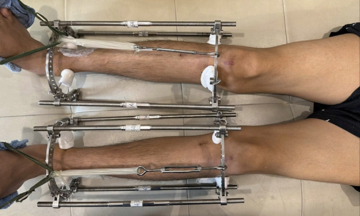Kidney failure, also known as renal failure, occurs when kidney function declines over an extended period, becoming irreversible. It progresses through five stages, from mild damage to complete loss of blood filtration, requiring dialysis or a kidney transplant. Each stage reflects the level of filtration decline, measured by the glomerular filtration rate (GFR).
Stage one: In this initial stage, the GFR is ≥ 90 ml/min/1.73 m2. Kidney filtration remains within the normal range, but there are signs of kidney damage, such as microalbuminuria (protein in the urine), abnormalities on imaging tests (like kidney ultrasounds), or underlying conditions like high blood pressure or diabetes. Symptoms are usually not apparent, and patients may feel healthy.
Individuals in stage one should manage underlying conditions like blood pressure and blood sugar, regularly monitor creatinine levels and urine, maintain a healthy lifestyle, including a low-sodium diet, adequate hydration, and avoidance of nephrotoxic medications (like non-steroidal anti-inflammatory drugs or NSAIDs).
Stage two: With a GFR between 60 and 89 ml/min/1.73 m2, kidney function begins to decline mildly but remains sufficient for most bodily functions. Early symptoms include mild fatigue, nighttime urination, and high blood pressure. Patients should adjust their diet (reducing protein if advised), have kidney function checked every three to six months, and avoid unnecessary nephrotoxic drugs.
Stage three: At this stage, the GFR falls between 30 and 59 ml/min/1.73 m2. Symptoms include persistent fatigue, mild anemia, darkened skin, and muscle cramps. Complications such as high blood pressure, electrolyte imbalances, and bone and joint problems may arise. Patients should collaborate with a nephrologist to manage blood pressure and blood sugar, reduce dietary protein as advised, and closely monitor creatinine, urea, and electrolyte levels.
Stage four: The GFR drops to 15-29 ml/min/1.73 m2, indicating a significant decline in kidney function. Preparation for renal replacement therapy becomes necessary. Severe anemia, itching, loss of appetite, nausea, swelling, resistant hypertension, and calcium-phosphorus imbalances are common symptoms. Close monitoring is essential to prepare for dialysis or transplantation.
Treatment options include hemodialysis, peritoneal dialysis, or kidney transplant.
Stage five (end-stage renal disease): With a GFR below 15 ml/min/1.73 m2, the kidneys almost completely lose their filtering ability. Renal replacement therapy is essential for survival. This stage is marked by severe fatigue, intense nausea and vomiting, generalized swelling, reduced urine output, loss of appetite, itching, and uremic coma.
Treatment options include hemodialysis three times a week, continuous ambulatory peritoneal dialysis, or kidney transplant if feasible. Psychological support, nutritional guidance, and management of related complications are crucial components of care.
Kidney failure is irreversible, but its progression can be controlled and slowed with early detection and adherence to treatment. Regular monitoring of kidney function, especially for those at high risk (individuals with diabetes, high blood pressure, older adults, or a family history of kidney disease), is crucial for long-term health.
Regular check-ups are the best way to protect your health, enabling early detection of serious conditions, including kidney failure.
How is the glomerular filtration rate (GFR) tested?: To assess kidney filtration, patients undergo blood creatinine tests and other tests like the estimated GFR (eGFR).
The GFR represents the plasma flow from the glomerulus into Bowman's capsule (the sac surrounding the glomerulus) over a specific time and is the primary measure of kidney function. The kidneys receive 20-25% of the blood pumped by the heart each minute (equivalent to 1-1.1 liters of blood per minute). Blood enters individual glomeruli through the afferent arteriole and exits through the efferent arteriole. Only plasma can pass through the glomerulus.
The eGFR is calculated using a formula based on blood creatinine levels, age, sex, and race. This test may be part of a routine health exam or ordered when a patient experiences kidney-related symptoms: reduced urine output, excessive urination, blood in the urine, foamy urine, pain in the mid-back near the kidneys, or swelling in the ankles, hands, feet, or face. Individuals with conditions that can affect the kidneys, such as diabetes, heart disease, high blood pressure, or a family history of kidney disease, may also undergo eGFR testing.
Early detection and management of kidney disease through regular GFR testing significantly reduce the risk of kidney failure. Patients diagnosed with kidney failure should not despair, as there are supportive treatments available, including hemodialysis, peritoneal dialysis, and kidney transplantation.
Bao Bao












